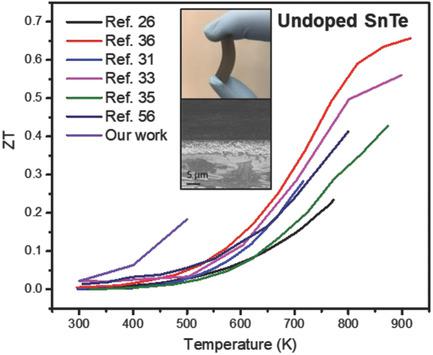Our official English website, www.x-mol.net, welcomes your feedback! (Note: you will need to create a separate account there.)
Controllable Colloidal Synthesis of Tin(II) Chalcogenide Nanocrystals and Their Solution‐Processed Flexible Thermoelectric Thin Films
Small ( IF 13.3 ) Pub Date : 2018-07-20 , DOI: 10.1002/smll.201801949 Deqiang Yin 1 , Chaochao Dun 2 , Xiang Gao 1 , Yang Liu 1 , Xian Zhang 3 , David L. Carroll 2 , Mark T. Swihart 1
Small ( IF 13.3 ) Pub Date : 2018-07-20 , DOI: 10.1002/smll.201801949 Deqiang Yin 1 , Chaochao Dun 2 , Xiang Gao 1 , Yang Liu 1 , Xian Zhang 3 , David L. Carroll 2 , Mark T. Swihart 1
Affiliation

|
A systematic colloidal synthesis approach to prepare tin(II, IV) chalcogenide nanocrystals with controllable valence and morphology is reported, and the preparation of solution‐processed nanostructured thermoelectric thin films from them is then demonstrated. Triangular SnS nanoplates with a recently‐reported π‐cubic structure, SnSe with various shapes (nanostars and both rectangular and hexagonal nanoplates), SnTe nanorods, and previously reported Sn(IV) chalcogenides, are obtained using different combinations of solvents and ligands with an Sn4+ precursor. These unique nanostructures and the lattice defects associated with their Sn‐rich composition allow the production of flexible thin films with competitive thermoelectric performance, exhibiting room temperature Seebeck coefficients of 115, 81, and 153 μV K−1 for SnS, SnSe, and SnTe films, respectively. Interestingly, a p‐type to n‐type transition is observed in SnS and SnSe due to partial anion loss during post‐synthesis annealing at 500 °C. A maximum figure of merit (ZT) value of 0.183 is achieved for an SnTe thin film at 500 K, exceeding ZT values from previous reports on SnTe at this temperature. Thus, a general strategy to prepare tin(II) chalcogenide nanocrystals is provided, and their potential for use in high‐performance flexible thin film thermoelectric generators is demonstrated.
中文翻译:

锡(II)硫族化物纳米晶体的可控胶体合成及其溶液处理的柔性热电薄膜
报道了一种系统的胶体合成方法,以制备具有可控价和形态的锡(II,IV)硫属元素化物纳米晶体,然后证明了由它们制备溶液加工的纳米结构热电薄膜的方法。使用溶剂和配体的不同组合获得具有最近报道的π立方结构的三角形SnS纳米板,具有各种形状的SnSe(纳米星以及矩形和六角形纳米板),SnTe纳米棒和先前报道的Sn(IV)硫族化物。 Sn 4+前体。这些独特的纳米结构和与其富锡成分相关的晶格缺陷使生产具有竞争性热电性能的柔性薄膜成为可能,其室温塞贝克系数为115、81和153μVK分别对于SnS,SnSe和SnTe薄膜为-1。有趣的是,由于在500°C的合成后退火过程中部分阴离子损失,在SnS和SnSe中观察到了从a型到n型的转变。SnTe薄膜在500 K时的最大品质因数(ZT)值为0.183,超过了先前在此温度下有关SnTe的报道的ZT值。因此,提供了制备硫族锡(II)纳米晶的一般策略,并证明了其在高性能柔性薄膜热电发生器中的应用潜力。
更新日期:2018-07-20
中文翻译:

锡(II)硫族化物纳米晶体的可控胶体合成及其溶液处理的柔性热电薄膜
报道了一种系统的胶体合成方法,以制备具有可控价和形态的锡(II,IV)硫属元素化物纳米晶体,然后证明了由它们制备溶液加工的纳米结构热电薄膜的方法。使用溶剂和配体的不同组合获得具有最近报道的π立方结构的三角形SnS纳米板,具有各种形状的SnSe(纳米星以及矩形和六角形纳米板),SnTe纳米棒和先前报道的Sn(IV)硫族化物。 Sn 4+前体。这些独特的纳米结构和与其富锡成分相关的晶格缺陷使生产具有竞争性热电性能的柔性薄膜成为可能,其室温塞贝克系数为115、81和153μVK分别对于SnS,SnSe和SnTe薄膜为-1。有趣的是,由于在500°C的合成后退火过程中部分阴离子损失,在SnS和SnSe中观察到了从a型到n型的转变。SnTe薄膜在500 K时的最大品质因数(ZT)值为0.183,超过了先前在此温度下有关SnTe的报道的ZT值。因此,提供了制备硫族锡(II)纳米晶的一般策略,并证明了其在高性能柔性薄膜热电发生器中的应用潜力。



























 京公网安备 11010802027423号
京公网安备 11010802027423号